Just in case I forget
(linky)
And
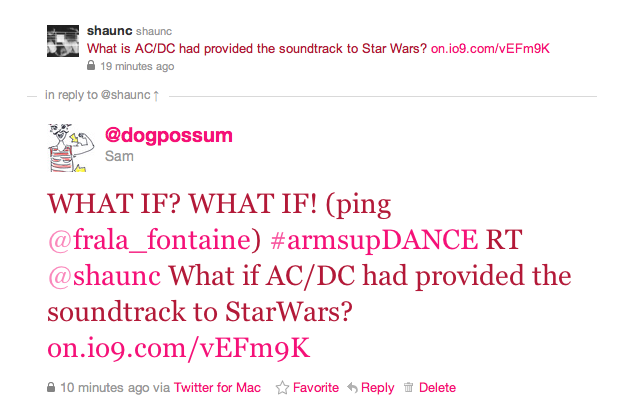
(linky)
All that talk about neo swing in that last blog post has had me thinking about zoot suits.
There’s lots of bullshit ‘scholarship’ around about zoot suits. The best thing I’ve ever read about them was a book chapter called “The Right to the City in Los Angeles: Discourse and Practice of a Chicano Alternative Public Sphere” by Raul H. Villa in the book Masses, classes and the public sphere edited by Mike Hill and Warren Montag (2000) (on Google Books).
One of the worst things I’ve ever read was Stuart Cosgrove’s article “The Zoot Suit and Style Warfare” in Angela McRobbie’s edited collection Zoot Suits and Second-Hand Dresses: An Anthology of Fashion and Music (1989). I know it’s a bit of a big call, picking on Cosgrove. But that article is wrongity wrongtown. In so many ways. I haven’t read it in a while, though, so I could be completely mistaken. I just remember it being scarily inaccurate. McRobbie’s talk about second hand dresses in the 80s is a lot more useful.
What is a zoot suit?
This article ‘The Zoot Suit Riots’ (from Manong: The Story of Raymond G. Perla
Photographs and storys from the Manong Generation) isn’t such a bad place to start for a description of the actual item of clothing. Basically, they were really big suits, using lots of fabric, which were popular with some latino/chicano youth in Los Angeles during the second world war. Using lots of fabric was kind of shocking in a time of wartime austerity. Of course, race and ethnicity are the most important parts of this story.
What did a zoot suit look like?
This is a picture of Edward James Olmos in the 1981 film film Zoot Suit:
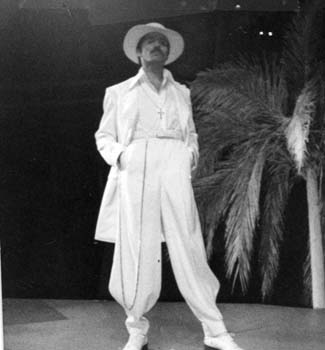
That film was strange sort of musical. You can find interesting bits of it on Youtube – search. But that’s an 80s version of the zoot suit. Here’s a cool photo of some bloke with Katherine Dunham in 1943. He’s not wearing a zoot suit, but he’s in a pose which looks a lot like a ‘pimp walk’, a key jazz step associated with zoot suits, pimps and swaggering cool. He may have mad skills and be super cool, but he’s not wearing a zoot suit.
Here’s a funny photo of Spike Lee (left) and Denzel Washington (right) in Lee’s 1992 film Malcolm X:
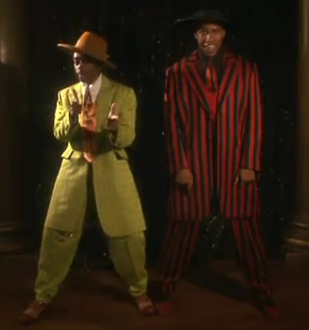
Even better, watch them strutting, pimp-walk style in one of the early scenes of the film here. Malcolm X’s autobiography has some interesting things to say about young black American men and zoot suits. Spike Lee’s film is interesting because so many hardcore totally legit and awesome lindy hoppers were involved in its production, including Frankie Manning and Norma Miller. The dance scene from the film was really influential in the burgeoning swing dance scene at the time. Enjoy the dubbing:
Lee specifically intended to have the film pay homage to the greatest lindy hoppers of the original period: the Whitey’s Lindy Hoppers, Frankie Manning, Norma Mmiller and so on. The dance scene from Malcolm X itself echoes iconic music and dance film sequences from the original swing era. You have only to compare that dance scene with the Jitterbug Contest from Keep Punchin’.
…but anyway, I was talking about zoot suits. Yeah, yeah, Malcolm X is good stuff. But it’s not really getting to the heart of the matter. Where are those Chicanos Villa talks about his fascinating story about Los Angeles?
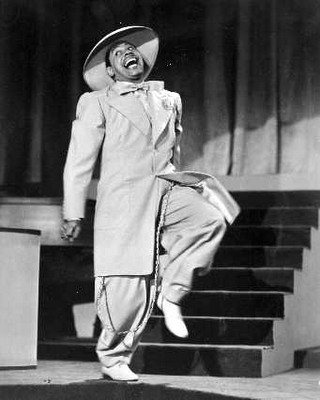
That’s Cab Calloway. But by the time this photo was taken, he was majorly famous. So he’s not really representing subversive public spheres… or is he? Look, I can’t really explore that here, but it’s worth thinking about Cab Calloway, ethnicity, race, the Cotton Club and performing identity.
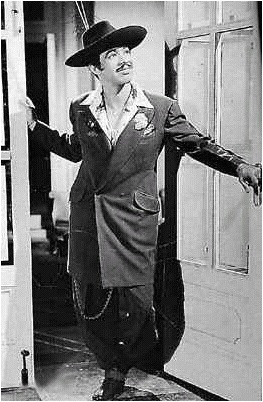
That’s a picture of Mexican star Tin Tan in 1945. I found it here on this interesting page about zoot suits. That page is actually part of a research guide discussing the play and film Zoot Suit. The play Zoot Suit premiered in LA in 1978 and was released as a film in 1981, “the first Chicano written, performed and directed feature length film in history” (to quote the site).
It’s also interesting to read Ephemeral New York blog post about vintage clothes in New York in the 80s. Forties and thirties fashion was kind of getting a reboot in the 80s (you can see it a bit in films like Desperately Seeking Susan and Pretty in Pink).
Wait. What has all this got to do with lindy hop today. WHY are the white ‘swing dancers’ in Sydney STILL wearing zoot suits?
Ok, so it’s the 80s, right. You’ve looked at that stuff I’ve just linked. Now, in the 80s, lindy hop starts getting a bit of a revival. Young American, British and European (Sweden!) dancers start hunting down living dancers from the 30s and 40s. You can watch a really cool interview with Al Minns, where he talks about the Swedes’ approaching him. In 1989 the band Royal Crown Revue is formed by Eddie Nichols, punk and son of a jazz singer.
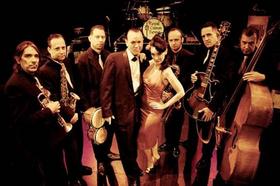
Neo swing is getting started. It has its roots in punk, ska, rock and roll. That’s where I remember it starting – my friends’ punk bands were support acts for visiting American bands like Royal Crown Revue, Cherry Poppin’ Daddies, Brian Setzer, Squirrel Nut Zippers, etc etc etc.
Ok, now it’s the 1990s. The film Swing Kids is released in 1993, Swingers in 1996. Lindy hop has gone mainstream. At least in America. In 1998 Gap release this ad for khakis. If Gap are using swing dancing for ads, you know it’s mainstream. I start dancing lindy hop in Brisbane in 1998, only a little while after classes started there. But it’d been in Sydney for a little while already. It’d only just started happening in Melbourne. We have the rock n roll and latin dance scenes to blame for lindy hop’s popularity in Sydney and Melbourne, and the influence of immigrant Brits.
Yeah, yeah, ZOOT SUITS?!
In 1997 the Cherry Poppin’ Daddies release a song called ‘Zoot Suit Riot’. It supposedly has something to do with the zoot suit riots.
Who’s your daddy? Yes I am.
I’m sure LA lindy hoppers watching that video can see lots of famous names and people. But when I watch that clip, all I can hear is the song, and all I can see is the first dance performance I did in public. ARGH. MY EARS.
And at the time, all those bright suits and big hats and black and white shoes had indy cred. That stuff was cool.
[EDIT: This is one of a number of loosely-associated posts about music in Sydney lindy hop today. This list includes:
]
[Edit 18/11/11: A nice little article about a Vintage Zoot Suit Auctioned for nearly $80K was posted to Yehoodi this week.]
This is a story about live music in Sydney, and how lindy hoppers and swing dancers use it and find it. I’m really going only on anecdotal evidence, backed up by my own supposition and thinking. I don’t have a lot of hardcore facts about the history of Sydney lindy hop to back me up. So I’ve tried to avoid talking about anything besides the 2008-2011 period, and to keep my comments about stuff I don’t know anything about to a minimum.
Sydney’s swing dancers like live music.
Perhaps the most important factor in attracting a dancing crowd to a live music gig is a sympathetic venue. This means venues actually letting dancers dance, and then understanding that they can cater to both dancing tight-arse dancers and drinking, non-dancing punters. The Unity Hall Hotel always hosts a group of dancers on Sunday. The Camelot Lounge hosts some of the best live jazz in Sydney (from interstate and local artists). Venue 505 has initiated its own dancer-centred gigs showcasing some astonishingly good Sydney musicians. The Sydney Festival always attracts a zillion dancers, particular events like the Trocadero Dance Palace and Spiegeltent. In contrast, while the Sydney Jazz Club hosts some of the finest jazz bands in the country (and from overseas), it uses venues with smaller dance floors, rubbish food and lame, ‘old people’ vibes. RSLs. Outdoor parks. Yacht club function rooms midday and mid-week.
Our live jazz music (music suitable for lindy hop or ball or blues or whatevs) scene is healthy: lots of good bands, made up of jazznick elder statesmen and young guns. The older jazznicks largely cater to a rapidly aging jazz fan base, neglecting a potentially lucrative market. This is a shame, as Sydney is home to some of the country’s finest (older) musicians. I can go on and on and on about the Ozcats. Or the Unity Hall Jazz band. But these musicians and bands have a weak online presence, relying on face to face promotion, flyer drops at events, local radio announcements and the powerful Sydney Jazz Club old school social network: word of mouth. Nanna power. Sydney lindy hoppers use a combination of online talk (mostly through faceplant) and face to face talk to decide which bands to go see and when.
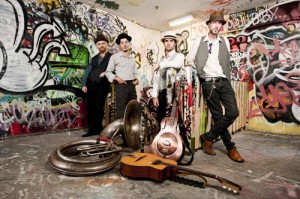
(The Cope Street Parade)
Younger jazz bands and musicians – many of whom have been associated with the Sydney Conservatorium of Music – are an interesting group. They’ve made good use of online tools. They have faceplant pages, myspace pages, a presence on sites like Reverb Nation, their own websites and occasionally twitter accounts. Faceplant is by far the most influential of these tools, but really only in concert with other media (a solid website or myspace page, soundclips or videos on faceplant itself). A group of these younger musicians are involved in a number of bands showcasing different types of early 20th century American folk music – from sacred singers (you can find the Surry Hills Sacred Harp Singers on faceplant) to bluegrass and hot jazz combos. They’re also launching a record label, Yum Yum Tree Records.
These musicians have strong relationships with younger lindy hoppers who travel or who are otherwise plugged into the modern lindy hopping world, via faceplant, youtube and other online social media. The Cope Street Parade has a core group of keen dancers following them to their (pretty much) weekly gigs. Cope Street’s popularity can no doubt be attributed to their musical style. They have much in common with popular American ‘street jazz’ bands like the Careless Lovers, Smoking Time Jazz Club, the massively popular Tuba Skinny and The Loose Marbles. This sort of music has been hugely popular with American and European lindy hoppers lately, and many of the younger Sydney dancers in particular are on board with this trend.
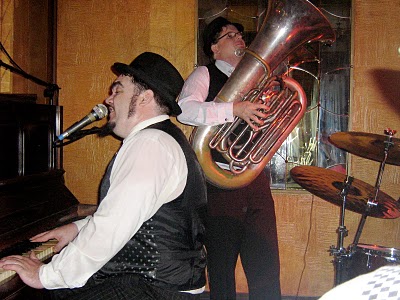
(image lifted from this site)
Pugsley Buzzard also has a keen fan base. His month long residency earlier in 2011 at The Mac in Surry Hills attracted dancers even with only a carpeted space for dancing. He’s also performed at the Sydney Lindy Exchange a few times, is booked in for the Sydney Swing Patrol christmas party next week, and has played for dancers at Canberrang this year. He is, sadly, relocating to Melbourne.
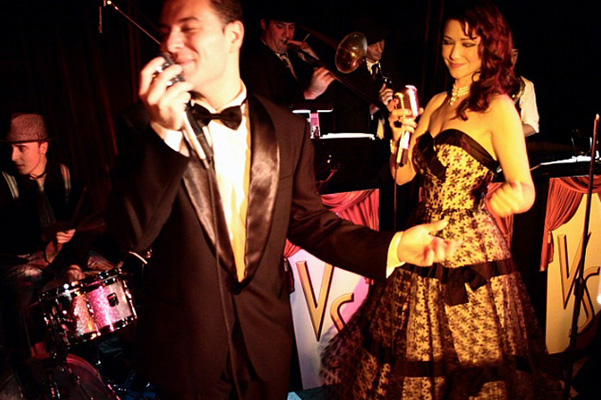
(The Velvet Set)
This brings me to the neo swing or ‘swing’ bands which cater to a slightly different audience. Bands like the The Velvet Set offer neo swing and crooner jazz rather than proper swing, but are very popular with ‘swing dancing’ crowd, some lindy hoppers and the rock n roll crowd. That’s what I want to talk about, but I think I need to talk a bit more about Sydney lindy hop and swing dancing demographics first.
I wonder if Sydney’s interest in live music is in part an indication of some of the troubles this scene has had over the last two four years. Sydney is an old scene – the oldest in Australia, founded in the mid 1990s or so. But its numbers and cultural complexity have fluctuated. Numbers had been down, with more experienced hardcore lindy hop dancers suffering some teaching fatigue and newer dancers not sticking around til they become hardcore. But our numbers have picked up in the last year. This means that Sydney is essentially a ‘newer’ scene and an older scene: a mix of very enthusiastic newer dancers and experienced dancers in a range of age groups.
It’s really not been until the last couple of years that we’ve seen Sydney dancers traveling to interstate events in significant numbers, though they have always travelled overseas, often in quite large numbers. There’s always been one or two or a handful at interstate events, but the last two years in particular have seen whole squads traveling to Melbourne, Perth, Adelaide, Canberra. All this travel within Australia has seen personal relationships developing between Sydney and interstate dancers. Relationships fostered by faceplant in a really important way: this is where people share videos and email addresses, encourage each other to visit again and finally get to talk to people they’ve only danced with. Interstate travel has also been important for making Sydney dancers aware of the limitations of their very small pond. They may be big fish at home, but they’re meeting and seeing and dancing with some much larger fish from much larger ponds. This sudden reality check can break a dancer’s confidence, but it can also spur a sudden interest in improving dancing skills. Competitions are, once again, a space where these sorts of realisations occur.
There are three (or four – I’m not sure exactly; the western suburbs are a mystery to me) major teaching entities in Sydney, and there isn’t a whole lot of interaction between all the schools. Two of these schools, catering for inner city and inner suburb areas – have plenty of students in common, which I think is a really good thing. If you provide diverse learning environments for students, you stimulate their interests and you create a market for mo social dancing and mo classes. Win! Only these two schools run DJed social dancing nights and have a real connection with other cities’ scenes and large events. The other schools are quite isolated, in terms of international lindy hopping culture, and I think this has had a detrimental effect on their dance skills and (dare I say it) musical taste.
But to get back to the whole neo swing thing, Sydney overall has a much stronger link with neo swing and rock n roll than Melbourne or other cities. There’s a hardcore lindy hopping/balboa crowd, but there’s an even larger group of dancers who are often older, began dancing in the 90s, or have much stronger links with rock n roll dancing and music. Many of the people guys often think of themselves as ‘swing dancers’ or ‘doing swing dance’, but I wouldn’t call them lindy hoppers. They may take the odd ‘swing dance’ class from lindy hoppers, but their first love is rock n roll (or rockabilly)
The younger ones are a lot more interested in looking good than the average lindy hopper. Many of them have stronger links with the goth or hardcore vintage fashion scene than with a dance scene. Dancing might be part of their social lives, but only part. Lindy hop tends to absorb your whole life, to become your lifestyle. This ‘swing’/rock n roll crowd have hardcore retro/vintage outfits, ride or drive vintage motorbikes or cars, and bring much more money to the bar. I suspect that their interest in looking good impedes their dancing ability. Rock n roll is easier than lindy hop, and guys can stand around looking good while they manhandle their (ALWAYS female) partners through endless spins. I am being quite harsh here, but while they look very good, this scene is not really all that when it comes to mad dance skills. Although, if you’re looking for a hot partner for a quick shag, this is a much better place to look than your average lindy hop scene.
The best attended live music events are in that neo swing/rock n roll vein.
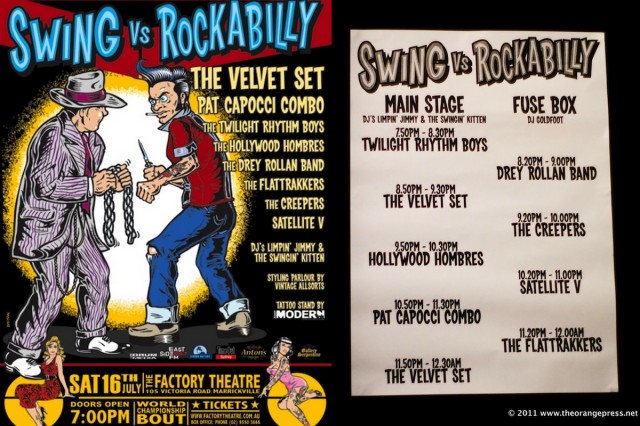
This Swing V Rockabilly poster is a good example of the sorts of things I’m trying to explain. The ‘swing’ guy in this poster (on the left) is what I associate with late 90s lindy hop – zoot suits, black and white shoes, wallet chains, hats. Very Hey-Pachuco! It kind of makes me cringe, because I associate it with the scene when I started dancing in Brisbane, and which I tend to associate with the neo swing scene, which was much more closely linked to ska and punk than jazz. Sure, it’s lots of fun – it was lots of fun – but the dancing was a bit rubbish, and it’s a bit dated. Lindy hoppers kind of got game these days.
Hardcore badass top shelf lindy hoppers look a bit more like this:
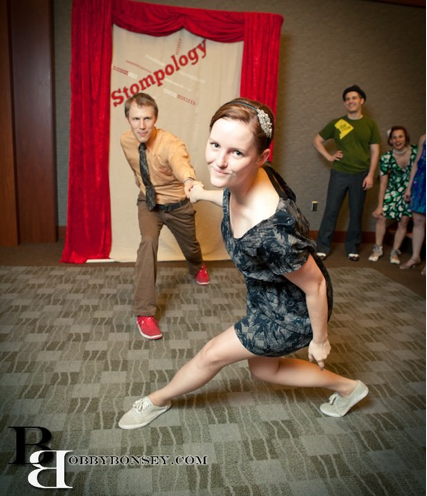
This is a photo by Bobby Bonsey, which I found here. He’s taken some really lovely photos of dancers. He’s also a badarse dancer. I particularly like this one of Chance and Giselle competing. I think that Bobby’s photos really capture the feel of American lindy hop today, which is much more athletic and physically exciting than 1990s Australian lindy hop. Lindy hoppers today look a lot more like the Whitey’s lindy hoppers – sinewy, fit, athletic. Like long distance runners or gymnasts. They wear form-fitting clothes that won’t impede their speed. They’re a long way from the zoot suits and silly cheap black and white shoes of the 1990s. And the ‘swing dance’ scene of Sydney today.
When I look at that ‘swing v rockabilly’ poster, I wouldn’t count any of those bands as ‘good lindy hopping bands’. They’re really rock and roll bands, but with mo brass. Most of them are quite good bands – lots of fun, lots of energy, good live shows. But not as musically accomplished as bands like Glenn Crytzer’s Blue Rhythm band. Crytzer’s band combines the exciting, rough-edged ‘authenticity’ of street jazz (and Meschiya Lake contributes in a big way to that feel in this clip) with solidly ‘authentic’ hot jazz instrumentation, arrangements and feeling. Here, let me show you what I mean:
This band feels like a real progresion – musically, technically, stylistically – from what’s been popular with dancers lately. Old school music and dancing. Street jazz ‘honesty’ and emotion. Exciting, committed musicians really connecting with dancers. Crytzer’s been engaged with the lindy hop scene in a big way (I’ve written about this before in Bands For Dancing), and his band is really top notch, swinging hot jazz. Also: uber exciting fun.
In contrast the Velvet Set are trotting out almost exactly the same set lists as swing DJs were playing twenty years ago. Crooners. Covers of ages-old neo swing songs. I don’t particularly like neo swing for lindy hop (because it doesn’t swing, and because it’s a bit naff), but I respect neo swing bands writing their own songs, improving their skills and really bringing their best to music they love. Here, check it out:
I don’t mean to badmouth the Velvet Set. They really are filling a niche in the market – there are plenty of dancers in Sydney who really like this stuff. They like the crooners, the covers of neo songs. Either because they were there in the 90s when this was the swing scene (this 2001 clip kind of gives you an idea of that scene), or because it moves them now. I think neo swing is accessible for many dancers – especially those from the rock n roll scene and new to lindy hop – because it’s a lot more like modern rock music and a lot less like proper swinging jazz. Swinging rhythms and hot jazz can be quite alien for new dancers, and neo swing has a clear, unswinging beat that sounds a lot safer. And people really like that pin-striped, zoot suit look.
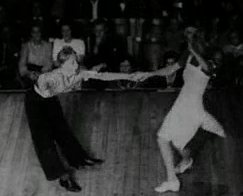
(img lifted from this 1944 newsreel)
This is quite interesting, because 1930s and 40s Australia really didn’t have the sort of ‘pure’ lindy hop culture that the US did. The sort of dancing these modern ‘swing dancers’ do, with its emphasis on 6-count steps like pass-bys, under-arm turns and so on (rather than the swingouts and more varied, complex counts and rhythms of lindy hop) actually look a lot more like the ‘swing dancers’ of the 1940s in this 1944 newsreel (thanks to Bobby White for reminding me of this).
This means that we nerds harping on about lindy hop – Harlem or LA – style, are actually less historically accurate (for our geography) than the ‘swing dancers’ at the Swing v Rockabilly gig. But then, a bunch of modern day middle class Sydney kids pretending to be working class black New York kids from the 30s is kind of dodgy, historically (and ideologically) speaking anyway.
To sum all that up, we’re looking at two different ‘swing dancing’ cultures in Sydney, the lindy hop one and the one more closely associated with rock n roll and neo swing. There’s lots of cross-pollination (usually lindy hoppers visiting ‘swing dance’ events), but they are distinct musical and dancing styles, and overall equate to a large Sydney dance scene which has always had strong links to the live music scene. It’s just that only one really gets into 1930s and 40s swinging jazz music. And that other likes it with a backbeat and a well-stocked bar. All this means that Sydney has a labouring DJing culture, a scene obsessed with live music, and lots and lots of social dancing nights – run by dancers and by local venues putting on bands.
Sydney’s interest in live music also means that we’ll turn out in force for visiting musicians from interstate or overseas. And by force, I mean a few hundred dancers – both hardcore lindy hoppers and ‘swing dancers’ of the more rock and roll variety. Sydney is a great town for live music, and that has bled into the dancing community, something that didn’t really happen in Melbourne, for instance, until very recently.
I might not be a fan of neo swing, but I do realise that having a vibrant partner dancing scene is a very good thing for lindy hop. And an interest in live music is good for musicians, and good for dancing.
[Edit: if you’re still struggling with the zoot suit thing, I wrote a post called zoot suit riot (riot) about it.]
[EDIT: This is one of a number of loosely-associated posts about music in Sydney lindy hop today. This list includes:
]
I’m doing some DJing at the upcoming MLX11 in Melbourne, and one of my sets is a blues/lindy crossover type set. In an ‘old school’ blues room. Usually these sets are a pain in the arse, but because I’m head DJ (aka BOSS OF ALL MLX DJS… i wish), I gave myself this brief:
Play slower swinging jazz and blues music. Sell it as ‘R Rated’ because that’s the sort of music you play anyway.
And I seem pretty cool with that task. So I’ve started putting together some stuff, the usual suspects. My goal is to play upenergy stuff rather than slow, quieter, mellow stuff. Again, as per usual. It’s going to be lots of fun. But I need to do some serious preparation as I’m a bit out of practice. Or rather, I don’t feel all that confident.
Alberta Hunter is kind of overdone these days, but this video reminded me of her excellence. I also think it’s kind of exciting to see an older woman up on stage talking way dirty and funny. The way she looks is really important.
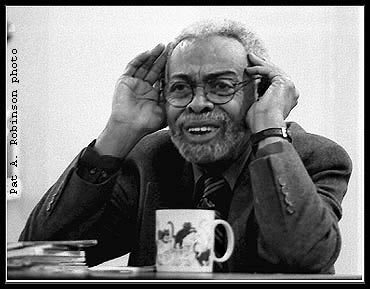
(Photo of Amiri Baraka by Pat A. Robinson, stoled from here).
Long time no post. I’ve been busy with a few different projects lately, most of them impeded by vast quantities of randomly-generated anxiety. I’m bossing some DJs for MLX11, I’m bossing some DJs locally, I’m sorting some solo dance practices, I’m looking at venues, I went to Church City Blues, I’m doing lots and lots of exercises to help my knees, I’m trying to improve my own DJing, and I’m working on at least two websites. They’re actually all the fun things. Also, we’ve started cooking meat at our house. The less said about that the better.
Perhaps the most challenging part of all this is trying to get my brain in gear for writing coherent sentences. More than one at a time. Ones that link up and make paragraphs. Anything more than that is really a little too ambitious right now. Writing. Why are you so demanding? The hardest thing in the world is writing properly when your brain won’t stop buzzing and fretting. Dance workshops? Actually quite good when you can’t make your brain shush. Forty minutes of slow, careful strengthening and stretching exercises every day? Quite calming, actually. But anything creative or requiring sustained creative thought – choreography, writing, editing… that shit is impossible. So here is something messy. Because it’s like learning to dance fast. If you never actually do it, you’ll never be any good at it.
Right now I’m thinking about writing about music. Again. I think it’s because I like to write about music. I’m also a woman. Wait – that last part is important (have vag will type). And because the things people write and say about music shape the way dancers and DJs think about music. And that affects the way they dance to music, which bands and DJs they hire to play their events, whether and how much they pay musicians and DJs, and what sort of music they put into the event programs. I know this is kind of old school literary studies/cultural studies/media studies stuff. And I even wrote about it in my PhD.
But now, I want to write and think about it again. Because I am organising DJs for MLX, and because I’ve noticed a clear trickle down (or bleed out?) affect from the developing online dancer discourse to the face-to-face. Yes. My PhD has come to life. Basically, Faceplant, blogs, podcast, youtube and all those other goodies are having a clear effect on face-to-face dance practice. Dancers are writing more about music (and dance), Faceplant has increased the penetration of this writing, and dancers are now reading more about music and dance. And this is having clear effects on how dance events are run. And on the interpersonal and institutional relationships and power dynamics of the international lindy hop scene. Yes, I will make that call. I can’t help it. I’m trained to see words as articulating power and ideology. And discourse as at once articulating ideology and creating it. I CAN’T HELP IT. I HAVE LEARNT TO USE MY BRAIN. ALL THIS THINKING WILL NO DOUBT RESULT IN THE COLLAPSE OF CIVILISATION AND RISE OF OUR FELINE OVERLORDS (WORSHIP THEM).
So what I’m saying, here, is that I’m getting that niggly tingly itchy feeling in the back of my brain that tells me there’s something going on that I need to pay attention to. Some dots are being joined. Unfortunately not by my conscious, rational brain, so you’re going to have to muddle through some fairly irritatingly vague, malformed or downright wrongtown blog posts til I get it together. If this was a magazine or an academic journal you’d be reading coherent sentences. But it’s not. So you’re getting dodgy stuff, but sooner. The fact that I’m still managing all those buzzing-brain anxiety issues means that it’s going to take me longer than usual to make this all into proper paragraphs. But then, I figure it’s a goddamn improvement on the past few months that I’m actually able to set fingertips to keyboard and make with the sentencing.
Words: why are you so demanding?!
I’ve been trying to get an idea of how jazz journalism works, both in historical and contemporary contexts. I’ve read a bit about the history of jazz journalism/criticism, a lot of which is really concerning. Lots of white, middle class guys writing about jazz, to paraphrase Amiri Baraka. Very few not-men, very few not-white anyones. To quote Baraka:
Most jazz critics began as hobbyists or boyishly brash members of the American petite bourgeoisie, whose only claim to any understanding about the music was that they knew it was different; or else they had once been brave enough to make a trip into a Negro slum to hear their favorite instrumentalists defame Western musical tradition. Most jazz critics were (and are) not only white middle-class Americans, but middle-brows as well. (Baraka, Amiri, “Jazz and the white critic”, The Jazz Cadence of American Culture, ed. O’Meally, Robert G. ed. New York: Columbia University Press, 1998: 137-142. pp 140)
Yeah! Baraka brings the smackdown! Old school 60s politics style!
What I have read has, for the most part, been really annoying. It’s kind of frustrating to see jazz studies – jazz criticism – failing to really get a grasp on gender and race politics. It’s like the 60s didn’t happen for so many of these guys. And it’s maddening to read the arguments that jazz histories emphasising black contributions are ‘racist’. Reminds me of those fuckwit people who try to argue that affirmative action policies are ‘reverse sexism’. …wait, I’m going to derail here for a bit of a rant:
IF we were all starting from the same place on the running track, it might be reverse sexism. But, dumbarse, we are working within PATRIARCHY, so affirmative action policy isn’t ‘reverse-sexism’, it’s simply an attempt to get us all at least onto the running track together. Of course, you’ve got to be a real ninja to actually pull off that sort of affirmative action effectively. So it’s ok, dickhead. Your power and privilege really aren’t in a whole lot of danger. We still have quite a bit of work to do. And anyway, most of our most important successes have been sneaky, and you haven’t noticed them. But, FYI, just like that beefcake guy in that rubbish film Crazy Stupid Love says, convincing women they’re learning to pole dance ‘for fitness’, that’s not a feminist victory. Convincing women stripping for money is empowering: that is not feminism. That’s old school sexism. So you’ve pretty much scored a point there.
…but back to my story.
Some of these jazz writer guys are entirely lacking in a sense of cultural and social context. And they really, really need to do a few introductory gender/race studies classes. Hellz, some introductory literary studies subjects.
But it’s worth having a look about at what has been written about race and class and gender and ethnicity in reference to and within jazz criticism. Queer studies? Yeah, don’t hold your breath, buddy.
So there is some critical (in the sense that these authors are engaging with the ideology and assumptions at work, rather than ‘being negative’) attention to jazz histories and jazz criticism/journalism. I’ve written a little bit about it before (in the post the trouble with linear jazz narratives + more and New Orleans jazz?), but I’m certainly not well read on this topic.

(Photo of Ellen Willis (with Bessie Smith), feminist and music journalist stoled from Ellen Willis tumblr)
That was made quite clear when I bitched (yet again) about the lack of women jazz journalists on twitter. @hawleyrose suggested I talk to @elementsofjazz (herself a woman jazz writer), who then hooked me up with Nate Chinen’s article On women in jazz (criticism) and Angelika Beener’s article Nice Work If We Can Get It: Women Writing on Jazz. Then I followed a million links from each of those articles to many more articles. The bottom line, here is that I mouthed off without researching the topic properly. I fell into that old ‘invisible women’ trap. Because I didn’t see women writing for big name jazz publications, I figured they didn’t exist. Just like that arsehat who recently bleated that there weren’t any women bloggers or tweeters writing about politics. With that bloke, the problem was a) that he defined ‘politics’ using the usual, very limited party-politics-institutions-and-polls definition and b) that he didn’t bother with bloggers and tweeters outside his usual sphere.
So my problem was a) I wasn’t looking in the right places (I was only looking in the conservative ‘official’ jazz journalism public sphere), and b) I hadn’t bothered to do much work to find those women journalists. Now I know better. And I’m delighted to be wrong. There are lots of women jazz journalists. Particularly when you broaden your definitions and include independent media, especially online media.
I think it’s worth talking about the history of jazz criticism here. And how small independent print publications were so important to the development of jazz criticism and writing from the turn of the century. But it’s also worth giving an eye (or ear) to the larger print publications like Esquire and Downbeat. I’ve written about this before, quite a few times, so I won’t go into it here (search for ‘magazines’ and you’ll find some old posts, or follow the links from More Esquire Talk).
What I do want to say, here, is that I’ve been thinking perhaps I should be asking “Are there any women writing about early jazz?” I’m wondering if the usual industrial and labour divisions of the early 20th century made it harder not only for women to get published, but for women to get read in the early days. And if there’s a resistance to writing about early jazz in the modern jazz publications and sites. Surely I’m once again voluntarily making women writers invisible. Surely. Time for more research, yes? YES!
The DJ on Friday played some supergroove and I was really in it. It was really nice to hear those smooth, in-the-pocket rhythms.
This is what I hope my dancing one day evolves to become.
Jerry Lewis – The Errand Boy (1961) Pantomime (song is ‘Blues in Hoss’s Flat’)
I’m afraid this isn’t a terribly well written or thought out post. Spring has struck, my sinuses are buzzing with histamines and my brain is running slow and foggy. But I wanted to join up all these issues before I forgot them.
So this is a story about liquor licensing, live music economies (financial and cultural) and dance cultures. It’s not terribly well researched or referenced, so please do go on and explore the issue rather than relying on my dodgy interpretation of events. I mean, buggered if I really know anything about liquor licensing in Australia and within Australian states.
The ABC story Live music injects $1b into economy (Lucy Carter and staff, Posted September 19, 2011 10:56:27) discusses a report on the economic value of the Australian live music scene commissioned by “industry stakeholders including the Australian Council for the Arts and the Australasian Performing Right Association (APRA)”.
- The study was limited to live music performances in pubs/bars, clubs, restaurants/cafes and nightclubs in Australia.
- the venues included in the study were limited to those in live music venues licensed by APRA that staged live music during the 2009/10 financial year.
- The study included only revenue generated from venue-based live music performances.
(pg 4)
The basic point here is that live music makes a significant contribution to the state and national economies, and is therefore important. This gains particular relevance in the context of ongoing battles over noise restrictions, the gentrification of urban spaces and the rezoning of areas where live music lives.
I need to note, here, that live jazz in Australia does not have broad appeal. It tends to cater to a much older demograph than most of the live music discussed in that report. But I think this is important. If live music is equated to ‘youth culture’ in popular discourse it marginalises an increasing (and increasingly influential) demograph and market: older audiences. I also think it’s important for jazz to reposition itself as a product for a more diverse audience. Bands like Virus in Melbourne did this well in the early 2000s, and New Orleans of course can pull this off because live music – of all types – is so thoroughly embedded in the mythos of the place. But live jazz is positioned as ‘art’ music rather than popular music in Sydney. Frankly, I think there should be more live jazz in everyday community spaces (like pubs), and this live jazz should be representative of the whole spectrum of ‘jazz’.
…though, personally, I want more of the hot jazz and less of the twiddlyfiddly arty stuff. Because it was designed and built as popular music and lots of fun to dance to.
My attention was caught by the fact that this was a study of venues serving alcohol and licensed by APRA because there’s been a recent discussion on Bug’s Question Of The Day FB page about paying cover charges, buying drinks and tipping at live music venues. The full question (15th September) reads:
I’ve noticed that, not only in New Orleans but every scene I’ve been to, dancers don’t want to pay a cover charge or tip the band. I’ve also heard from venue owners that dancers are notorious for not buying drinks. Why are we as a community resistant to supporting the musicians and venues? Do we not know any better? If so, how do we educate the community?
Drinking and tipping and cover charges at live music gigs are an issue for lindy hoppers because most dancers don’t drink much while dancing. Simply because it’s a demanding game, and drinking impairs your dance skills. So a venue that depends on drinking to cover the cost of live music is not going to make it, financially, if their clientele is made up entirely of lindy hoppers. The amount dancers drink really depends on the gig – the time of day, the vibe and so on. So they will drink, just not at every gig, every time. If we were to depend on live music for our entire scene, I think a reasonable standard of dancing would require spaces that focussed on dancing, rather than drinking. Ballrooms, dance halls and cabaret clubs with more physical room and a greater emphasis on dancing as well as bars and pubs where the social focus is more diverse.
I don’t think it’s a terribly good idea to promote drinking generally in a culture like Australia’s where binge drinking is a serious social issue, but I don’t want to suggest that I think drinking is wrong or bad. Basically, lindy hop events aren’t like other social events at licensed venues in Australia, and I think it’s a really good thing (and the thing I enjoy most about dance events) that young men and women (and older men and women!) can enjoy social events and dancing without getting shitfaced. I think that social and cultural practices and spaces should be centred on more than just drinking, not that social and cultural spaces should exclude drinking. Diverse cultural spaces make for diverse and vibrant communities, cross-generationally.
I don’t drink, so I don’t buy alcohol at live music gigs. I’m not a huge soft drink fan, so I don’t buy softies. I’ll buy a mineral water with lime, or some chips. But I like pubs. I like their casual drop-in culture where you can meet friends for a quick drink or a long meal. I like the way live music is an important part of pub culture. But I’ve been been struck by the differences between Melbourne pub culture (which I really like) and Sydney pub culture, which is a lot less pleasant.
There are different laws and licenses in each Australian state, and local licensing laws are often regulated by local councils – eg in Melbourne local city councils regulate licenses. A venue can lose its liquor license if it breaches noise level laws or serves under age customers. I have some problems with the way licensing works in Sydney, mostly because licenses are very expensive, and geared towards larger venues subsidised by on-site gambling (whether a TAB, Kino or pokies). Licensing in Sydney seems (at first and cursory glance) to promote pubs and licensed venues as places to get totally shitfaced, rather than places to meet friends, share a meal, listen to a band, play trivia, read, laugh, talk or get shitfaced. They’re simply more diverse community spaces in Melbourne than in Sydney. While even I’d drop into a pub in Melbourne on my own to drink or eat at the main bar, I’d feel a lot less comfortable at most Sydney pubs, because I’m not there to drop a million dollars in the pokies or the TAB or to drink a jug of beer on my own at lunch time.
This is where my knowledge really breaks down, but the way licensing works is affected by the influence of Clubs Australia, an influential interests group representing social clubs (like RSLs, Sporting clubs, etc). Pubs and clubs are different, legally and culturally, but in Sydney large corporations own a string of pubs and interests in clubs. Their main source of income from these businesses is gambling, or more specifically, pokies. Pokies are a scourge on the earth, encouraging people to sit and drop coins into a machine for hours and hours at a time. This type of gambling targets lower income earners and I think it’s promoters are ethically fail. Pokies also degrade the conviviality of a local pub – people sit in front of a machine rather than a bar, conversation is impeded by the loud noises and attention required to pull a lever. Live music and pokies are fundamentally incompatible: you can’t make good music in a room full of pokie machines. And pubs depending on pokies for revenue will devote valuable floor space (whole rooms!) to pokies rather than less profitable bands.
There’s been speculation about the effect of pokies on pub culture, and news articles like this Daily Telegraph one from earlier this year suggest that a focus on pokies has led to a neglect of drinkers. Of real, live people. I’d argue that chain pubs, run by an absent owner, are not community-oriented spaces at all. And pubs that are most culturally and socially relevant spaces are local spaces. Which is why one suburb in Melbourne can host so many small pubs – each serves a particular local clientele and offers a specific ‘experience’. Grand Final afternoon is perhaps the best example of this sort of localised specialisation, but the live music culture is just as useful an illustration of the cultural value of smaller, independently owned and operated pubs.
The federal government is currently considering revisions to the legislation affecting pokies, and Clubs Australia is spending an awful lot of money on advertising to drum up opposition to the changes. I’m curious to see how it all pans out. There are very few convincing arguments for promoting pokies, and many convincing arguments against it.
And here is where I’ll have to leave my discussion of pokies and licensing specifics, as I’m a bit histamine-crazy and generally ignorant of the facts. But I wanted to link up this news article, reference that Bugs Question, and the also something about the recent sale of the Unity Hall Hotel in Balmain to a corporate entity who owns a chain of pubs.
Unity Hall hosts one of Australia’s best jazz bands every Sunday afternoon. Musicians passing through town regularly drop in to play a few songs, so you’ll see all sorts of brilliant Australian (and visiting) musicians. For my money, this is the best dancing music in town. Dancers go there to dance, and there’s no cover charge. The bar staff charge the locals less for drinks than dancers (which is totally ok by me), but dancers who do turn up (and who pretty much count as regulars, though not necessarily locals) always buy drinks and chips and maintain a good relationship with bar staff and musicians.
While this is the best opportunity for hardcore dancing, it’s a small venue, and dancers need to share it with ‘nondancers’. Or, in other words, ‘normal folk’ who like to dance but don’t spend a million hours on dance classes. Because it is in a non dancer-run space, dancers need to engage their real social skills. Talking. Hanging out. Dealing with dickheads off the street. I think it’s a good place to learn floor craft (safety first!), to engage your social skills (conversate!) and to enjoy and support quality live music. Unity Hall isn’t as ‘good’ a pub as the best independent pubs in Melbourne – it does have a TAB taking up lots of space, and pokies, and it isn’t properly cross-generational (though it’s getting there), or multicultural (though even Melbourne pubs don’t really rock the multiculturalism). But it’s one of the better Sydney pubs, and I really hope the it doesn’t change for the worse with its new owners.
The sale of the Unity Hall hotel is indicative of how many pubs in Sydney are run: by big businesses who own a chain of pubs and treat them as warehouses for the real money makers – pokie machines. This is a bit shit when you compare it to Melbourne where there’s a strong independent pub culture, which results in brilliant food, child/family friendly pubs (which are also popular with the young and hip), live music venues and bar staff and owners who know their clientele and give a shit. Basically, venues which are owned and operated by members of the local community for the local community are more likely to give a shit about the local community and be important community spaces. Whether you’re looking for awesome food, locally sourced beers, live music, somewhere to dance, somewhere to talk, or just a quiet spot for a quick pint at lunch time.
I know my perception of Sydney pubs as community spaces is biased by my experiences in urban Melbourne (and I don’t mean to feed into the Syd/Melb rivalry), but I think state-based licensing laws are significant when we’re talking about dancers’ obligations at live music venues. Honestly, if licenses were less expensive, venues wouldn’t be so dependent on drinks’ sales and gambling to cover their costs. They could operate on a smaller profit margin, offering more specific and niche services – good food, niche music, smaller premises – and not need to rely on shit like pokies and promoting binge drinking. They could be more responsible and responsive community spaces.
[Edit: I need to read ”
A history of machine gambling in the NSW club
industry: from community benefit to
commercialisation” by Nerilee Hing]